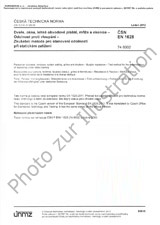Wir benötigen Ihre Einwilligung zur Verwendung der einzelnen Daten, damit Sie unter anderem Informationen zu Ihren Interessen einsehen können. Klicken Sie auf "OK", um Ihre Zustimmung zu erteilen.
ČSN EN ISO 21268-3 (836230)
Soil quality - Leaching procedures for subsequent chemical and ecotoxicological testing of soil and soil-like materials - Part 3: Up-flow percolation test
Name übersetzen
NORM herausgegeben am 1.4.2020
Informationen über die Norm:
Bezeichnung normen: ČSN EN ISO 21268-3
Zeichen: 836230
Katalog-Nummer: 509298
Ausgabedatum normen: 1.4.2020
SKU: NS-989717
Zahl der Seiten: 48
Gewicht ca.: 144 g (0.32 Pfund)
Land: Tschechische technische Norm
Kategorie: Technische Normen ČSN
Kategorie - ähnliche Normen:
Die Annotation des Normtextes ČSN EN ISO 21268-3 (836230):
This document specifies a test, which is aimed at determining the leaching behaviour of inorganic and organic substances from a soil and soil-like materials. The method is a once-through up-flow percolation test under standardized conditions of flow rate. The material is leached under dynamic hydraulic conditions. The document has been developed to measure the release of inorganic and organic substances from soil and soil-like material as well as to produce eluates for subsequent ecotoxicological testing. For ecotoxicological testing, see ISO 15799[6] and ISO 17616[7]. The test results enable the distinction between different release patterns, for instance wash-out and release under the influence of interaction with the matrix, when approaching local equilibrium between material and leachant.
This test method produces eluates, which can subsequently be characterized by physical, chemical and ecotoxicological methods in accordance with existing standard methods. The results of eluate analysis are presented as a function of the liquid/solid (L/S) ratio. The test is not suitable for substances that are volatile under ambient conditions.
NOTE 1 - Volatile organic substances include the low-molecular-weight substances in mixtures such as mineral oil.
NOTE 2 - It is not always possible to optimize test conditions simultaneously for inorganic and organic substances and optimum test conditions can also vary between different groups of organic substances. Test requirements for organic substances are generally more stringent than those for inorganic substances. The test conditions suitable for measuring the release of organic substances will generally also be applicable to inorganic substances.
NOTE 3 - Within the category of organic substances, a significant difference in behaviour exists between the more polar, relatively water-soluble compounds and apolar, hydrophobic organic substances (HOCs). In the latter case, mechanisms of release (e.g. particle-bound or dissolved organic carbon-bound) can be more crucial as well as sorption losses of soluble HOCs on different materials with which they come in contact (e.g. bottles, filters). The test and the results should be used for leaching of organic substances only with thorough consideration of the specific properties of the substances in question and the associated potential problems.
NOTE 4 - For ecotoxicological testing, eluates representing the release of both inorganic and organic substances are needed. In this document, ecotoxicological testing is also meant to include genotoxicological testing.
NOTE 5 - The test is generally not suitable for soils with hydraulic conductivities below 10-8 m/s (see also Annex B). It can be difficult to maintain the designated flow rate already in the range of saturated hydraulic conductivity between 10-7 m/s and 10-8 m/s.
The application of this test method alone is not sufficient for the determination of the leaching behaviour of a material under specified conditions different to those from the test procedure, since this generally requires the application of several test methods, behavioural modelling and model validation. This document does not address issues related to health and safety. It only determines the leaching properties as outlined in Clause 4
Normansicht ČSN EN ISO 21268-3 (836230)
Empfehlungen:
Aktualisierung der technischen Normen
Wollen Sie sich sicher sein, dass Sie nur die gültigen technischen Normen verwenden?
Wir bieten Ihnen eine Lösung, die Ihnen eine Monatsübersicht über die Aktualität der von Ihnen angewandten Normen sicher stellt.
Brauchen Sie mehr Informationen? Sehen Sie sich diese Seite an.




 Cookies
Cookies
